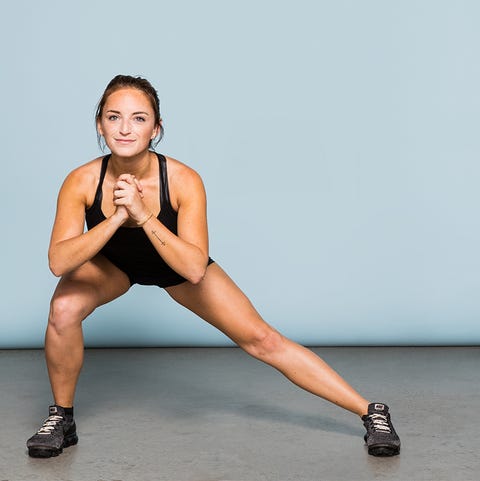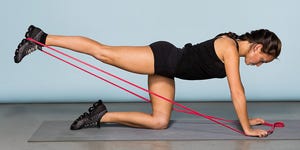This Move Will Tone Your Glutes ASAP

Working out while listening to an audiobook, squeezing in your workout during your commute by biking there—gotta love anything that kills two birds with one stone. Add side lunges to that list: “What makes side lunges so good is that the more you practice them, the stronger and more mobile you will be,” says New York-based trainer Chris Ryan, C.S.C.S., founding instructor at MIRROR. In other words, they’ll help you say hello to stronger glutes, and goodbye to tight AF hips.
How To Do A Side Lunge
How to: Start with your feet shoulder-width apart, toes pointed straight forward. Step out with your right foot as wide as possible. Engage through the right heel as you drop your hips down and back while keeping the left leg straight, stretching the groin on the left leg and keeping both soles of the feet on the ground and toes pointed straight forward. Make sure your right knee is tracking over your right foot the whole motion. Powerfully “punch” your right heel into the floor to push yourself back to the full standing start position. That’s one rep.
Form note: Make sure you’re sitting down and back, like in a basic squat rather than hinging at the hips. Also, plant your foot firmly on the ground at full extension, and keep your toes pointed forward throughout the whole move.
Reps/sets you should do to see results: Complete 8 to 12 reps on the right side, then repeat on the left side. Do 3 to 4 sets.
Benefits Of Side Lunges
Tightness in the groin, hip, and ankle can make this move challenging. But the more you do side lunges, the more you’ll ditch those issues, Ryan says. The move will open up tight hips and groin, while strengthening the inner thigh and glutes.
Make The Side Lunge Part Of Your Workout
“Side lunges are like avocado: good by themselves, but even better when paired with something fun and slightly spicy,” Ryan says. Incorporate the side lunge into your warm-up, or as part of any strength or HIIT workout. In a workout, side lunges pair well with any strength move—squats and reverse lunges on lower-body day, or as a complement to upper-body exercises for a total-body strength day.

“With any dynamic movement like side lunge, master the basic body weight movement first to work on a strong form, then worry about adding a load later,” Ryan says.
More advanced variations on side lunges: Once you’ve perfected your form without weights, add a kettlebell or dumbbell—which will also turn the move into a core toner, Ryan suggests. Or add a pulse, where you stay in the bottom of the side lunge, and slowly move an inch up and down. You’ll tone your glutes even more, and still score that full range of motion that will help decrease tightness in your hips.
Ryan recommends adding this move to your routine two to three times a week, “to make sure you stay loose, strong, and toned while avoiding overuse injuries.”
Source: Read Full Article
